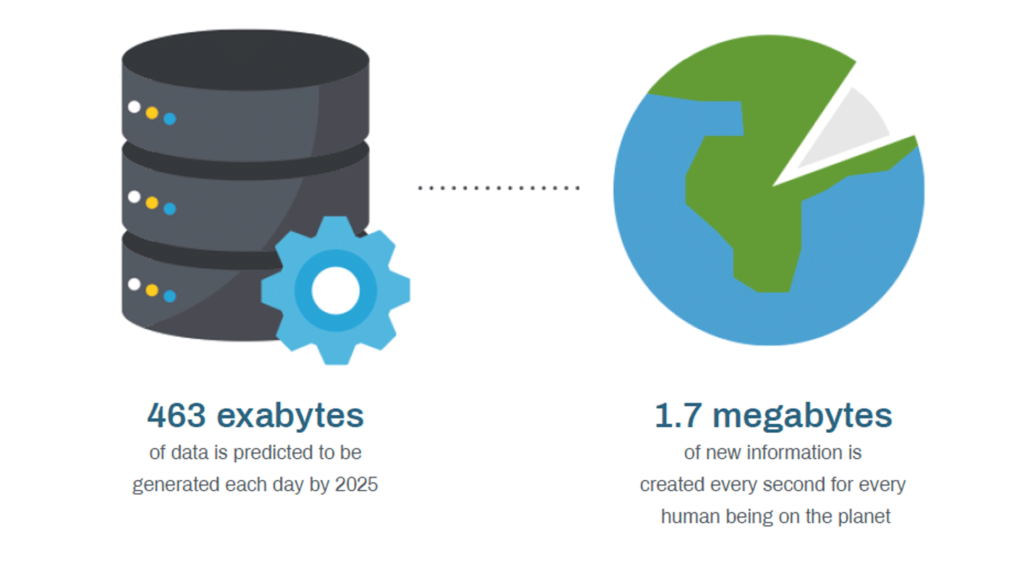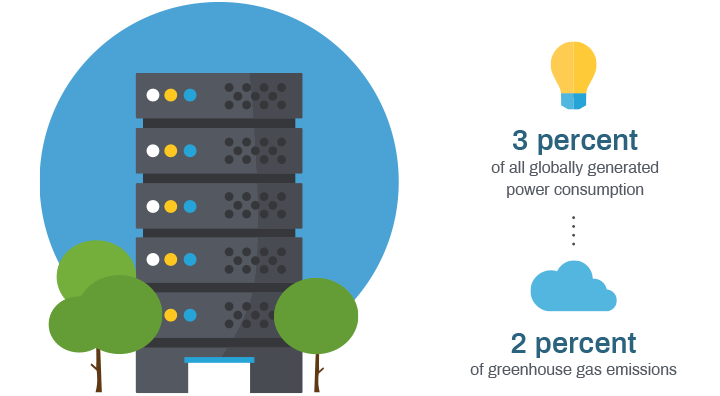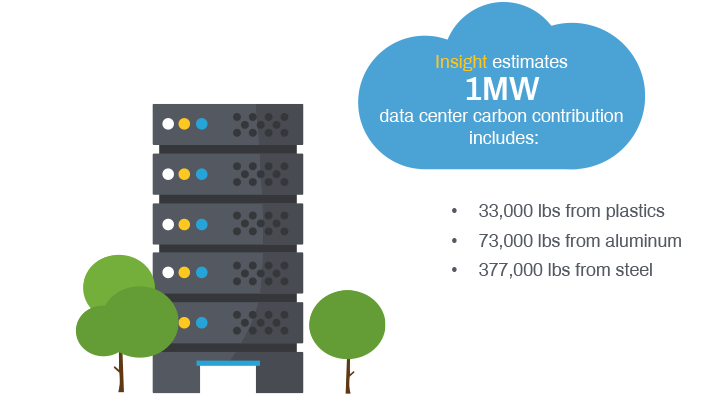Reduce your data center’s carbon footprint and support sustainability goals.
White Paper Sustainable Decommissioning
Sustainable Data Center Decommissioning
This is a significant time for sustainable development. In a historic 2015 UN summit, the United Nations (UN) member states adopted the 2030 agenda for sustainable development.
On January 1, 2016 the 17 Sustainable Development Goals (SDGs) came into force. Later that same year the Paris Agreement on climate change, which addresses the need to limit the rise of global temperatures, was ratified by 175 countries.

Data centers are among the highest consumers of power today. But with the internet of things, growing big data and expanding connectivity, the need for more and more of these facilities is inevitable. Data center sustainability is becoming a priority.
Data Center Frontier, April 4, 2019
The development of IT is generally seen as a force for good – an enabler toward an equitable and more sustainable world. But data needs are growing, as current estimates disclose:
It takes a huge amount of energy to manufacture, install and run global data centers to meet these growing data needs. With more than 7,117 colocation data centers, as well as hyperscale and wholesale data centers in existence, ensuring that data centers are as environmentally sustainable as possible is a concern of growing importance.
Should a Company’s Data Management be Part of Their Sustainability Conversation?
According to a study, data centers contribute approximately:

In fact, several institutions predict that data center energy usage could account for over 10% of the global electricity supply by 2030.
Many data center users and providers recognize this and are pioneering environmentally responsible data management. According to Data Center Frontier, “the data center industry is focusing on sustainability as never before, with the executive suite and customers aligned on the importance of using renewable energy to power digital infrastructure.”
Sustainability in the Data Center: What does that look like?
LEED-Certified Data Centers
Leadership in Energy and Environmental Design (LEED) – developed by the U.S. Green Building Council – is a set of rating systems for the design, construction, operation and maintenance of green buildings. LEED has developed a certification for sustainable design and construction of data centers. Less than five percent of all U.S. data centers have LEED certification.
Facebook, requires that their data centers achieve LEED gold level certification; “With each new data center we build, we add more renewable energy to the grid. And we make sure that all of our renewable energy projects are in the same electric grid as our data centers… our data centers are already 80 percent more efficient than the average data center.”
Characteristics of a ‘sustainable’ data center are considered by LEED to have/be;
- Advanced cooling systems to reduce energy consumption
- Improved cooling efficiency
- Reduced energy consumption
- A clean backup power system (reducing emissions, noise pollution and fuel consumption)
- Using renewable energy
- Green construction (recycled materials, reducing distance raw materials move, diverting waste)
- Intelligent design
Many data centers looking to improve their green credentials invest in ISO50001 accreditation for Energy Management. This ISO certification supports organizations in all sectors to use energy more efficiently, through the development of an energy management system.
The existing accreditations focus on build and in-life use of the data center, none consider end-of-life equipment age and lifespan possibilities or opportunities.
Sustainable Lifecycle Management
There are opportunities for data center users, owners and operators to boost their sustainability credentials and offset their carbon footprint by integrating lifecycle thinking into the design, operation and decommissioning of hardware. The opportunities can be broadly grouped as;
- Commitment to sustainable end-of-life management
- Opportunities for reuse
- Material recovery for remanufacturing
Sustainable End-of-Life Management
Data centers can demonstrate their commitment to sustainability by promising to stop throwing away any aging, broken and end-of-life assets and equipment from their facilities. By doing this it diverts waste from landfill and promotes the case for reuse and recycling.
Data centers that make their own custom servers have the opportunity to partner with recycling technicians to consider reuse into their design. This might give their equipment the ability to operate longer, the possibility to be repaired and refurbished easily, and to incorporate only materials that can be recycled without residual materials going to landfill.
Opportunities for Reuse

When equipment reaches the end of its economical life companies can engage a credible third-party IT asset disposition (ITAD) operator for IT asset recovery. This might involve the recovery, repair, reuse and remarketing of complete units, parts and components, and base materials within the data center environment or outside of it.
The first value recovery option is to redeploy whole or part units into a company’s own environment. This can be supported by an ITAD company, such as Sims Lifecycle Services (SLS), that supports decommissioning, data wiping, audit testing, cleaning and redeployment. For data centers this is not just an exercise in sustainability, it is also a way to save money by leveraging reuse and recycling efforts to reduce costs.
Second-hand Market
Second-hand units can be sold into what is known as the ‘second-hand market’. This can be the case for either entire servers, or parts and components. By engaging with an experienced ITAD company like SLS to manage your reuse and resale program you gain control over these units. This gives you the ability to manage this in line with new product launches.
Making informed decisions about equipment placed on the second hand market can create an additional revenue stream for a business. At a time when the economical life of a server is ending, ITAD companies help to add market value to a device that has most likely been depreciated to zero on the books. This revenue could then become a budget to help fund more sustainability efforts.
Pulling equipment for redeployment
Reuse allows for cost avoidance opportunities. Redeployment options can feed into repair and manufacturing streams. If an organization manufactures its own custom servers reusable parts can be identified in legacy equipment for the manufacture of new products. Or for any data center operator, reclaimed parts can be deployed into repair centers to support maintenance contracts.
Reuse diverts waste from landfill, reduces the reliance on mining virgin materials and reduces the impact of manufacturing electronics.
Materials Recovery for Remanufacturing
In addition to reducing carbon emissions from data center energy use, materials recycling can contribute to offsetting the impact of mining virgin raw materials for new data center equipment.
One major technology company identified in their environmental responsibility report that “…the carbon footprint of our manufacturing processes represents the largest portion of our impact on climate change. Every year we investigate more deeply into our supply chain, constantly analyzing inefficiencies and developing ways to help our suppliers make less of an impact on the planet.” Many of the resources used to create data centers are finite.

Spotlight: Recyclable Materials in Data Centers
Organizations must make strategic decisions when buying new material, and it starts with their sourcing supply chains. An original equipment manufacturer (OEM) that implements sustainable sourcing and practices is usually favored over one who does not.
Plastics: Traditional plastics production involves the transformation of petroleum or natural gas into their constituent monomers. The process is highly energy intensive and has been estimated to account for 1 percent of total greenhouse gas emissions. The carbon footprint of recycled plastics is a mere fraction of that of virgin plastics.n of that of virgin plastics.
Aluminum: Traditional aluminum production uses a large amount of electricity to break the bond between oxygen and aluminum in aluminum-oxide. Recycling aluminum saves 90-95 percent of the energy needed to make aluminum from bauxite ore. There is no limit to how many times aluminum can be recycled.
Steel: Recycling one tonne of steel saves 1,100 kgs. of iron ore, 630 kgs. of coal, and 55 kgs. of limestone. Steel recycling uses 74 percent less energy, 90 percent and 40 percent less water than virgin steel production. It also produces 76 percent fewer water pollutants, 86 percent fewer air pollutants, and 97percent less mining waste.
These materials make up the majority of material, by weight, in a typical data center. Additional valuable materials reside within the printed circuit boards (PCBs), processing chips and power supplies within the server units, such as valuable precious metals (i.e. gold, copper and silver).
Gold: One tonne of modern PCBs might contain five ounces (around $6,000 worth) of gold.
Tantalum: This is commonly found in processors and capacitors. Tantalum is a critical raw material with a current end-of-life recycling rate of less than-one percent.
Lead: This is found in batteries in data center universal power supplies (UPS). Lead is highly toxic when disposed of irresponsibly. Professional recycling diverts this dangerous waste from landfill and avoids environmental and human health impacts.
Copper: This is a key component in wiring and printed circuit boards. Although newer wiring contains less copper than older units, like all metals, copper can be infinitely recycled to avoid raw material mining and reduce energy emissions.
Some of the minerals used in server production have been identified as conflict materials. These usually involve materials mined in the eastern provinces of the Democratic Republic of Congo and its neighboring countries. Resulting revenues from the purchase of these raw materials are known to be financing, directly or indirectly, armed groups engaged in civil war resulting in serious social and environmental abuses.
Materials included in the conflict materials group, known as 3TG, include Tin, Tantalum, Tungsten and Gold. These are all commonly found in data center equipment. Using recycled materials helps divert revenues away from mining enterprises for these conflict materials.
Diverting Materials From Irresponsible Recycling
If not recycled properly, electronic waste can be a serious health and environmental issue. To make a quick profit, unethical recyclers sometimes dump e-waste or use dangerous techniques that can leach toxins and harm the environment. Using a responsible recycler ensures material is diverted from these sites.
SLS’s Top Advice for Sustainable Data Center Lifecycle Management
1. Avoid Stockpiling Redundant Assets
Not only does this monopolize valuable floor space that could be used for revenue generating equipment, but data breach risk aggregates when it is left unmanaged.
As equipment is stockpiled, value reduces as assets idle in a dusty corner. While equipment is stored SLS estimates that value reduces 3-5 percent per month. Potential clients may identify this as evidence of weakness in a process and the temptation exists to adopt less secure methods of data destruction. This ultimately increases the risk of a security lapse and decreases the chance to recoup value.
Support for a sustainable and environmental reuse and recycling program will likely rely on it also being secure and value-driven. An ITAD and e-Recycling partner should offer a solution that delivers data security and value recovery with equal importance to sustainability.
2. Follow the Waste Hierarchy: Reduce > Reuse > Recycle
Most ITAD and e-Recycling partners can support the refurbishment and repair of assets to be redeployed into a company’s own environment.
Reuse of materials or equipment, avoids the greatest amount of energy emissions, and delivers the highest value in many cases. Even if whole units cannot be reused look for opportunities to reuse parts and components.
End-of-life equipment should be recycled. Some ITAD vendors may outsource this service. It is important for Data Center Managers to understand who the recycler is and how equipment will be responsibly recycled to protect their company’s brand reputation.
3. Think Global but Keep it Local
It is always better to have businesses working with vendors that can recycle material in the region where it was collected. Where possible it is better to avoid shipping overseas for disposal. Businesses will need to always seek evidence and assurance that recycled materials are not being dumped in developing countries once handed over to a disposition vendor. This applies to their downstream vendors also, so look for evidence of a robust downstream vendor management system.
An operator’s geographical footprint should meet the needs of the company and matches their locations. Recyclers should also be able to offer a full range of lifecycle management services – IT asset disposition and e-Recycling.
4. Enforce Accountability
Setting targets for a company’s end-of-life data center equipment sustainability goals is a great way to set forth some accountability. It is helpful for many to share their goals with the organization, and measure progress against them. Examples of goals might include:
- What percentage of equipment do you want to redeploy, reuse and recycle?
- What is the ambition for energy and emissions avoidance? (This goal might be considered as a percentage of the footprint from data usage – offsetting the impact)
5. Choose the Right Partner
Sustainability credentials should not be the only determinant in a partner choice. It is recommended to look for a financially-stable company, with experience and the ability to produce references from reputable organizations. Once it has been established that a chosen vendor has the ability to deliver, check that their ethics and values match as well to create the best possible partnership.
6. Talk About it!
Celebrate what you do. Managers should talk about their sustainable and secure ITAD and e-Recycling programs and use it as a sales tool. Look for a company that provides sustainability certificates and the ability to demonstrate an organization’s contribution to environmental protection goals.
The Time for Change is Now
Companies are starting to take responsibility for their brand by facilitating a closed-loop program that contributes to the circular economy. This supports the drive to address global resource scarcity by facilitating this urban mining of valuable and scarce materials.
As the data center industry continues to grow, it is necessary for more data centers to integrate reuse and recycling programs into their process to help minimize e-waste volumes by diverting waste from landfills. Green data centers can reduce the environmental impact of their data consumption and increase the productivity of their data center assets. In addition, they can reduce the social impact of their data usage by lowering their organization’s reliance on conflict materials, and minimizing their risk of irresponsible recycling of equipment in the informal recycling sector.